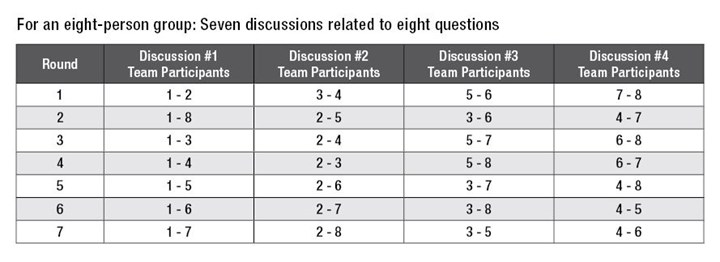A Brainstorming Technique to Increase Manufacturing Employee Engagement
This technique works for just about any type of question for which independent and unbiased answers are sought.
Through the years, I have employed various brainstorming techniques for the purpose of obtaining employee input on key issues facing different organizations. There are certainly many techniques to choose from, and some have worked quite well, while others have left me unsure of whether I really got the information I was seeking.
Recently, I learned of a technique that engages participants and prevents domination of the conversation by a few, which always tends to sway the ideas of others. I have employed this structured brainstorming technique in a number of instances with some pretty impressive results. I am not sure if the technique goes by a specific name, but I liken it to speed dating. The technique works as follows:
- Break participants into small groups. Six or eight people per group seems to work well, with an even number making the process much more manageable and ensuring full engagement of participants.
- Set up chairs in two equal lines facing each other, with one chair per participant.
- Give everyone in the group one question for which they are responsible to ask. Have them collect answers, as well. If there are multiple groups, give each group the same questions (unless you want to get answers to a lot of different questions in one session).
- To start, teams of two participants sit face-to-face, and the first participant asks the participant facing him or her the assigned question and records the answer.
- Next, the second participant does the same with his or her question.
- A total of four minutes is allowed for the two participants to ask their questions (approximately two minutes per question). This keeps the process moving and prevents unwanted conversation. Interestingly, most teams finish well within the four minute time limit, even though this time seems very short at first.
- At the end of the four minutes, the teams are notified (a bell or whistle works well), and all discussion stops.
- Each participant then sits with a different participant, forming a new team of two sitting face-to-face.
- The process repeats until each participant has met with every other participant in the group and has asked each question. There will always be one less round of discussion than the total number of participants. For example, six participants will ask and be asked questions five different times during the brainstorming session.
- Each participant records the answers he or she has collected on a chart or other display that is visible to everyone in the group.
- Group discussion then occurs, but the most frequent answers to the questions are typically given highest priority for further action.
When following this brainstorming technique, it is best not to have the participants select their discussion partners for each round as this can get a little complicated. Instead, a chart like the one below should be developed ahead of time, to minimize delay.

Such a chart can be modified to reflect the number of participants and rounds of discussion needed to answer all of the questions.
This structured brainstorming technique works for just about any type of question for which independent and unbiased answers are sought. Questions involving safety, product quality, process issues, continuous improvement, new equipment, customer service, key performance indicators (KPIs), cost reduction and even new product development are especially well-suited to such an approach.
Try this technique the next time you want to solicit input from your team. I think you will find it to be an effective way of increasing the engagement of your employees, which could generate a wealth of new ideas for your organization to consider.
Related Content
6 Tips for Training on a Swiss-Type Lathe
There are nuances to training a person to effectively operate a Swiss-type lathe. Derek Korn, Production Machining’s editor in chief, shares suggestions from a CNC machine shop.
Read MoreAll-Around Mill Improves Productivity and Cost for Valve Job
Adopting a mill with a double-negative rake and pockets compatible with multiple insert geometries enabled Progressive Metal Service to increase feed and lower scrap rates for a valve.
Read MoreCan Connecting ERP to Machine Tool Monitoring Address the Workforce Challenge?
It can if RFID tags are added. Here is how this startup sees a local Internet of Things aiding CNC machine shops.
Read MoreSolve Worker Shortages With ACE Workforce Development
The America’s Cutting Edge (ACE) program is addressing the current shortage in trained and available workers by offering no-cost online and in-person training opportunities in CNC machining and metrology.
Read MoreRead Next
Use the SMART Criteria to Develop Your Company's Goals
Be SMART, and use these five characteristics to improve your company.
Read More3 Mistakes That Cause CNC Programs to Fail
Despite enhancements to manufacturing technology, there are still issues today that can cause programs to fail. These failures can cause lost time, scrapped parts, damaged machines and even injured operators.
Read More













.png;maxWidth=300;quality=90)












